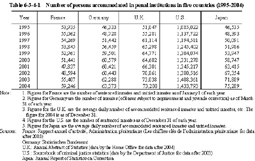| Previous Next Index Image Index Year Selection | |
|
|
1 Trend of accommodation in penal institutions (1) Background
The trend of accommodation in penal institutions has been affected significantly by the trend of criminal trials, and in particular, on sentencing.
The number of newly admitted inmates marked the lowest record after WWII at 20,864 persons in 1992, but started to increase in 1993 and has increased continuously up to 2005. The number was 32,789 in 2005, which was an increase of 57.2% from 1992. Looking at the changes in the percent ratio by term of imprisonment since 2000, the ratio for persons sentenced to imprisonment for "over one year but two years or less" has been the largest but on a declining trend, while that for persons sentenced to imprisonment for over two years has been on a rise. There is an overall tendency that the number of persons sentenced to imprisonment without suspension of execution of sentence has been increasing and the terms of imprisonment have been lengthening, which has caused overcrowding of penal institutions (see Part 2, Chapter 4, Section 1). (2) Trend of accommodation and burdens on officials
The average daily number of persons accommodated in overall penal institutions, which has shown a trend similar to the number of newly admitted inmates, marked the lowest record after WWII at 44,876 persons in 1992, but started to increase in 1993 and has increased continuously up to 2005. The number was 77,932 in 2005, which was an increase of 73.7% from 1992 (see Part 2, Chapter 4, Section 1, 2).
Table 6-3-4-1 shows trends in the number of persons accommodated in penal institutions in five countries (Japan, France, Germany, the U.K., and the U.S.) for 10 years between 1995 and 2004. Systems concerning penal institutions vary by country and we cannot compare data in a simple manner. However, figures for France, Germany and the U.K. were rather similar to those for Japan. The numbers of persons accommodated in penal institutions in Germany and the U.K. have shown trends similar to that in Japan, showing an increasing trend since 1995. The number in France was decreasing from 1997 to 2001 but has been on a rise since 2002. In contrast, the number in the U.S. has been much larger than that in the other four countries and has increased consistently. Assuming the number of persons accommodated in penal institutions in 1995 as 100, the index for 2004 was highest for Japan (161.8), followed by the U.K. (143.4), Germany (136.8), the U.S. (132.1), and France (109.8). Table 6-3-4-1 Number of persons accommodated in penal institutions in five countries (1995-2004) The occupancy rate of overall penal institutions continued to increase since 1993 and marked a record high in 2002, but has been slightly decreasing since 2003, partly due to increased imprisonment capacity. However, penal institutions have still been overcrowded, and the rate for sentenced inmates, in particular, was as high as 116.0% as of December 31, 2005 (see Part 2, Chapter 4, Section 1, 1).Overcrowding has also increased burdens on officials in penal institutions. The burden rate per penal institution official (the rate obtained by dividing the average daily number of persons accommodated in overall penal institutions by overall fixed number of officials at the end of relevant fiscal year) increased gradually from 2.8 in 1996 to 3.0 in 1998 and 4.4 in 2005. Burden on officials has thus become heavier (Source: Correction Bureau, Ministry of Justice). As the total number of inmates increased, an increase has also been observed in inmates who have a conspicuous tendency not to fit to group treatment and are apt to cause troubles with other people, such as those with severe mental and physical influence caused by abuse of stimulants, etc. or those with personality disorder. It is often difficult to make them observe rules in penal institutions and do their work in an orderly manner. Treatment of such inmates has caused a great deal of burdens to officials. |
